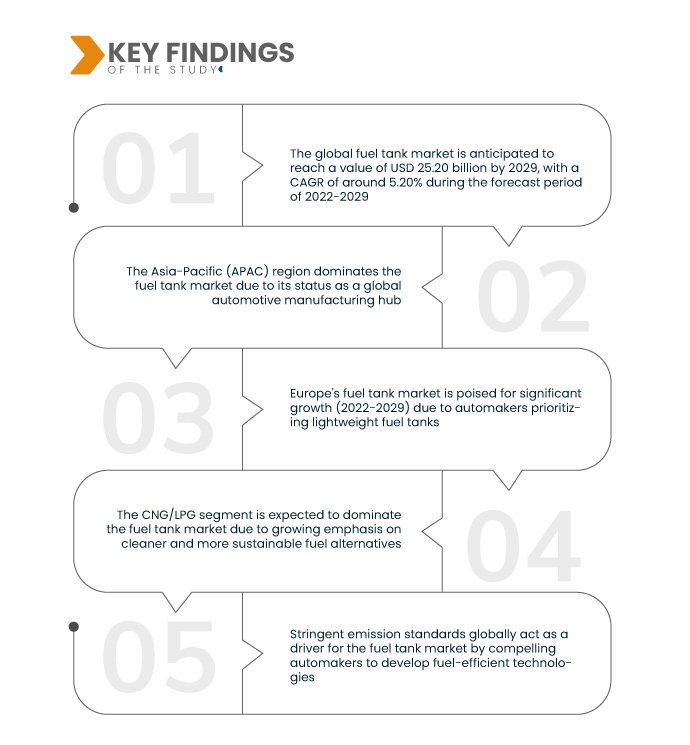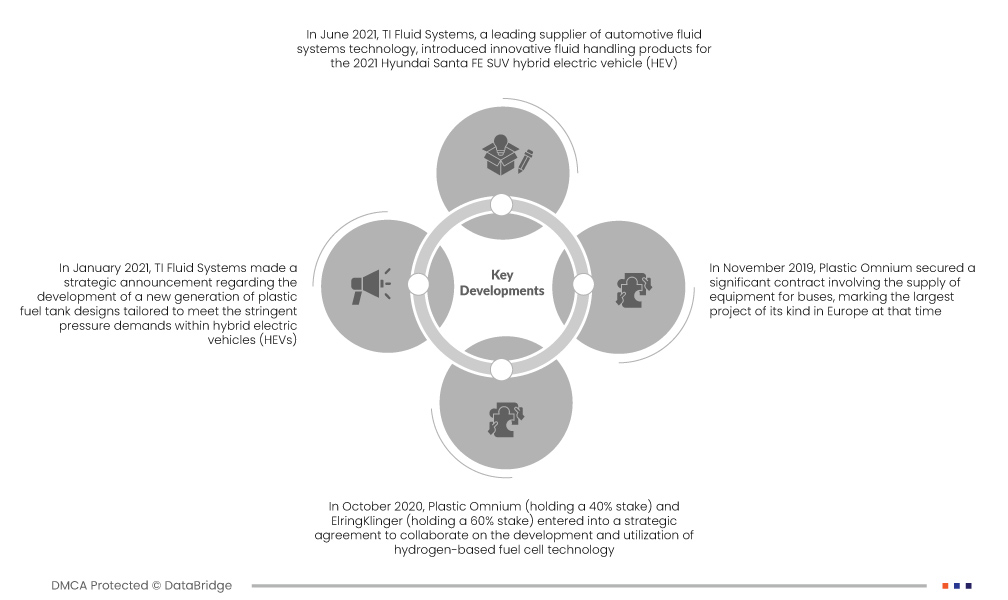Топливный бак напрямую влияет на производительность транспортного средства, безопасность и соответствие экологическим нормам. Эффективные конструкции топливных баков способствуют общему снижению веса транспортного средства, повышению топливной экономичности и соблюдению строгих стандартов выбросов. С ростом числа электрических и гибридных транспортных средств рынок играет жизненно важную роль в разработке передовых решений для хранения энергии. Кроме того, инновации в технологиях топливных баков поддерживают глобальные усилия по обеспечению устойчивого транспорта, решая экологические проблемы.
Доступ к полному отчету по адресу https://www.databridgemarketresearch.com/reports/global-fuel-tank-market
Data Bridge Market Research анализирует, что глобальный рынок топливных баков оценивался в 16,80 млрд долларов США в 2021 году и, как ожидается, достигнет 25,20 млрд долларов США к 2029 году, регистрируя среднегодовой темп роста 5,20% в прогнозируемый период 2022-2029 годов. Рынок топливных баков обусловлен ростом производства автомобилей для удовлетворения потребностей потребителей, параллельно наблюдается всплеск спроса на топливные баки и основные компоненты для транспортных средств, что стимулирует рост рынка топливных баков.
Основные выводы исследования
Ожидается, что усиление государственной политики и стимулов будет способствовать росту рынка.
Государственные стимулы и политика играют ключевую роль в развитии рынка топливных баков, влияя на тенденции в производстве автомобилей. Налоговые льготы для экологичных транспортных средств и правила, способствующие повышению топливной эффективности, побуждают автопроизводителей инвестировать в передовые технологии топливных баков. Производители вынуждены разрабатывать легкие и эффективные топливные баки, чтобы соответствовать нормативным стандартам и иметь право на государственные стимулы. Эта динамика поощряет инновации в конструкции топливных баков, материалах и производственных процессах, формируя рыночный ландшафт и способствуя принятию экологически чистых и экономичных транспортных средств. В результате государственные инициативы становятся важным фактором, способствующим прогрессу на рынке топливных баков.
Область отчета и сегментация рынка
Отчет Метрика
|
Подробности
|
Прогнозируемый период
|
2022-2029
|
Базовый год
|
2021
|
Исторические годы
|
2020 (Можно настроить на 2014-2019)
|
Количественные единицы
|
Выручка в млрд долл. США, объемы в единицах, цены в долл. США
|
Охваченные сегменты
|
Емкость бака (менее 45 л, 45–70 л и более 70 л), тип материала (пластик, алюминий , сталь, другие), вес (менее 7 кг, от 7 до 10 кг, более 70 кг), тип топлива (СНГ/СПГ, дизельное топливо, бензин ), тип двигателя (природный газ, водород, двигатель внутреннего сгорания (ДВС), гибрид), канал продаж (OEM, вторичный рынок), тип транспортного средства (легковые автомобили, легкие коммерческие автомобили, тяжелые коммерческие автомобили, гибридные автомобили)
|
Страны, охваченные
|
США, Канада, Мексика, Бразилия, Аргентина, Остальные страны Южной Америки, Германия, Италия, Великобритания, Франция, Испания, Нидерланды, Бельгия, Швейцария, Турция, Россия, Остальные страны Европы, Япония, Китай, Индия, Южная Корея, Австралия, Сингапур, Малайзия, Таиланд, Индонезия, Филиппины, Остальные страны Азиатско-Тихоокеанского региона, Саудовская Аравия, ОАЭ, Южная Африка, Египет, Израиль, Остальные страны Ближнего Востока и Африки
|
Охваченные участники рынка
|
TI Fluid Systems (Великобритания), Yachiyo Industry Co., Ltd. (Япония), Magna International Inc. (Канада), Plastic Omnium (Франция), Unipres Corporation (США), Kautex (Германия), ContiTech AG (Германия), SMA Serbatoi SpA (Италия), FTS CO.,LTD. (Япония), Crefact Corporation (США), Boyd Welding LLC (США), Elkamet Kunststofftechnik GmbH (Германия), Salzburger Aluminium Group (Австрия), Central Precision Limited (Великобритания), Arrow Radiators (Melksham) Ltd (Великобритания), A. KAYSER AUTOMOTIVE SYSTEMS GmbH (Германия) и PIOLAX, Inc (Япония) и другие
|
Указатели данных
|
Помимо таких рыночных данных, как рыночная стоимость, темпы роста, сегменты рынка, географический охват, участники рынка и рыночный сценарий, рыночный отчет, подготовленный командой Data Bridge Market Research, включает в себя углубленный экспертный анализ, анализ импорта/экспорта, анализ цен, анализ потребления продукции и анализ пестицидов.
|
Анализ сегмента:
Мировой рынок топливных баков сегментирован по таким параметрам, как емкость бака, тип материала, вес, тип топлива, тип двигателя, канал продаж и тип транспортного средства.
- На основе емкости бака рынок сегментируется на менее 45 л, 45 л -70 л и более 70 л. Ожидается, что сегмент менее 45 л будет доминировать на рынке с CAGR 5,5% в прогнозируемый период 2022-2029 гг. Он доминирует на рынке из-за растущего спроса на компактные и экономичные автомобили, поскольку меньшие емкости баков соответствуют тенденции к легким и экологичным конструкциям, отвечая предпочтениям городских потребителей и нормативным стандартам топливной эффективности.
- На основе типа материала рынок сегментирован на пластик, алюминий, сталь и другие. Ожидается, что пластик будет доминировать на рынке с CAGR 5,0%. Он доминирует на рынке топливных баков благодаря своей легкости, коррозионной стойкости и гибкости конструкции, что способствует повышению топливной экономичности и соблюдению строгих норм выбросов.
- На основе веса рынок сегментирован на менее 7 кг, от 7 до 10 кг и более 70 кг. Ожидается, что сегмент менее 7 кг будет доминировать на рынке с CAGR 6,8%. Он доминирует на рынке из-за растущего акцента на легкие материалы и топливную экономичность в автомобильной промышленности.
- На основе типа топлива рынок сегментирован на LPG/CNG, бензин и дизельное топливо. Ожидается, что сегмент CNG/LPG будет доминировать на рынке с CAGR 5,3% из-за растущего глобального акцента на экологически чистые и устойчивые варианты топлива
Ожидается, что сегмент КПГ/СНГ будет доминировать на мировом рынке топливных баков в прогнозируемый период 2022-2029 гг.
Ожидается, что сегмент CNG/LPG будет доминировать на рынке топливных баков с CAGR 5,3% из-за растущего акцента на более чистых и устойчивых альтернативных видах топлива. С ростом экологических проблем и мер регулирования, способствующих сокращению выбросов, сжатый природный газ (CNG) и сжиженный нефтяной газ (LPG) приобрели популярность как более чистое топливо. Этот сдвиг стимулирует спрос на транспортные средства, оснащенные системами CNG/LPG, следовательно, стимулируя рынок специализированных топливных баков, предназначенных для хранения и транспортировки этих альтернативных видов топлива.
- На основе типа тяги рынок сегментирован на двигатель внутреннего сгорания (ДВС), природный газ, водород и гибрид. Ожидается, что сегмент природного газа будет доминировать на рынке с CAGR 5,8%. Он доминирует на рынке из-за растущего интереса к более чистым и устойчивым источникам энергии
- На основе канала продаж рынок сегментирован на OEM и вторичный рынок. Ожидается, что сегмент OEM будет доминировать на рынке, поскольку автопроизводители обычно закупают топливные баки напрямую у производителей, чтобы беспрепятственно интегрировать их в новые автомобили в процессе производства. Ожидается, что он будет расти со среднегодовым темпом роста 4,5%
- На основе типа транспортного средства рынок сегментируется на легковые автомобили, легкие коммерческие автомобили, тяжелые коммерческие автомобили и гибридные автомобили. Ожидается, что сегмент легковых автомобилей будет доминировать на рынке с CAGR 5,3%. Он доминирует на рынке из-за растущего мирового спроса на автомобили, особенно на развивающихся рынках
Ожидается, что сегмент легковых автомобилей будет доминировать на мировом рынке топливных баков в прогнозируемый период 2022–2029 гг.
Доминирование сегмента легковых автомобилей на рынке топливных баков с CAGR 5,3% из-за чистого объема потребительского спроса на личный транспорт. С ростом населения мира и ростом урбанизации спрос на легковые автомобили, включая автомобили, остается стабильно высоким. Более строгие экологические нормы и переход к топливной эффективности также привели к инновациям в технологиях топливных баков для легковых автомобилей, что еще больше способствовало их доминированию на рынке.
Основные игроки
Компания Data Bridge Market Research выделяет следующие компании в качестве основных игроков на мировом рынке топливных баков: TI Fluid Systems (Великобритания), Yachiyo Industry Co., Ltd. (Япония), Magna International Inc. (Канада), Plastic Omnium (Франция), Unipres Corporation (США), Kautex (Германия).
Развитие рынка
- В июне 2021 года компания TI Fluid Systems, ведущий поставщик технологий автомобильных жидкостных систем, представила инновационные продукты для обработки жидкостей для гибридного электромобиля (HEV) Hyundai Santa FE SUV 2021 года. Эти продукты были специально разработаны для улучшения топливных систем, демонстрируя опыт TI Fluid Systems в оптимизации систем с помощью легких решений. Акцент на легких компонентах направлен на повышение эффективности режима электромобиля (EV) на Hyundai Santa FE SUV HEV
- В январе 2021 года компания TI Fluid Systems сделала стратегическое заявление о разработке нового поколения пластиковых топливных баков, специально разработанных для удовлетворения строгих требований к давлению в гибридных электромобилях (HEV). Это технологическое развитие достигло важной вехи с началом массового производства в сотрудничестве с Volkswagen China. Пластиковый топливный бак был реализован в моделях подключаемых гибридных электромобилей (PHEV) Passat и Magotan. Успешный запуск ознаменовал собой шаг вперед в решении проблем, связанных с требованиями к давлению в HEV, с планами по внедрению этой технологии в более широком спектре глобальных платформ.
- В октябре 2020 года Plastic Omnium (с долей 40%) и ElringKlinger (с долей 60%) заключили стратегическое соглашение о сотрудничестве в разработке и использовании технологии топливных элементов на основе водорода. Целью этого сотрудничества было использование опыта обеих компаний в продвижении решений в области топливных элементов. Соглашение ознаменовало собой значительную инициативу по исследованию и внедрению технологии водородных топливных элементов, подчеркнув совместные усилия по содействию развитию чистых и устойчивых энергетических решений в автомобильном секторе.
- В ноябре 2019 года Plastic Omnium заключила крупный контракт на поставку оборудования для автобусов, что стало крупнейшим проектом такого рода в Европе на тот момент. Эта стратегическая инициатива внесла значительный вклад в рост выручки компании. Контракт, в частности, включал поставку различных автомобильных компонентов, потенциально охватывающих топливные баки, системы контроля выбросов или другое специализированное оборудование, предназначенное для автобусов. Сделка не только подчеркнула возможности Plastic Omnium в автомобильном секторе, но и позиционировала компанию как ключевого игрока на растущем рынке компонентов для автобусов. Такие предприятия в различных автомобильных сегментах часто усиливают общее присутствие компании на рынке и ее финансовые показатели.
Региональный анализ
Географически в отчете о мировом рынке топливных баков представлены следующие страны: США, Канада, Мексика, Бразилия, Аргентина, остальные страны Южной Америки, Германия, Италия, Великобритания, Франция, Испания, Нидерланды, Бельгия, Швейцария, Турция, Россия, остальные страны Европы, Япония, Китай, Индия, Южная Корея, Австралия, Сингапур, Малайзия, Таиланд, Индонезия, Филиппины, остальные страны Азиатско-Тихоокеанского региона, Саудовская Аравия, ОАЭ, Южная Африка, Египет, Израиль, остальные страны Ближнего Востока и Африки.
Согласно анализу Data Bridge Market Research:
Азиатско-Тихоокеанский регион будет доминирующим регионом на мировом рынке топливных баков в прогнозируемый период 2022-2029 гг.
Доминирование Азиатско-Тихоокеанского региона (APAC) на рынке топливных баков обусловлено его ролью как глобального центра производства автомобилей, особенно в таких странах, как Китай, Япония, Южная Корея и Индия. Быстрое экономическое развитие региона, растущее население среднего класса, урбанизация и инфраструктурные проекты привели к существенному увеличению производства легковых автомобилей. Правительственные инициативы, благоприятная нормативная база и сотрудничество с мировыми автопроизводителями дополнительно способствуют росту автомобильного сектора в APAC.
По оценкам, Европа станет самым быстрорастущим регионом на мировом рынке топливных баков в прогнозируемый период 2022–2029 гг.
Ожидается, что Европа испытает значительный рост в прогнозируемый период с 2022 по 2029 год из-за повышенного внимания автопроизводителей к принятию легких топливных баков. Этот акцент обусловлен необходимостью снижения общего веса транспортных средств, что является критической стратегией для соответствия строгим стандартам топливной эффективности и выбросов, установленным европейскими регулирующими органами. В рамках более широкой тенденции к устойчивому развитию технологические инновации в материалах и производственных процессах позволяют производить легкие, но прочные топливные баки.
Для получения более подробной информации об отчете о мировом рынке топливных баков нажмите здесь – https://www.databridgemarketresearch.com/reports/global-fuel-tank-market












